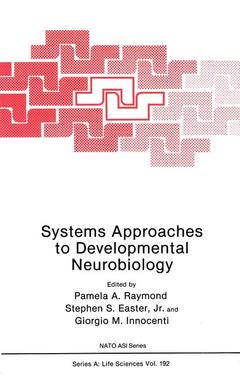Description
Systems Approaches to Developmental Neurobiology, Softcover reprint of the original 1st ed. 1990
NATO Science Series A: Series, Vol. 192
Coordinators: Raymond Pamela A., Easter Jr. Stephen S., Innocenti Giorgio M.
Language: English
Subjects for Systems Approaches to Developmental Neurobiology:
Keywords
Invertebrate; Nervous System; Vertebrate; attention; biology; development; genes; neurobiology
Publication date: 12-2012
204 p. · 17x24.4 cm · Paperback
204 p. · 17x24.4 cm · Paperback
Description
/li>Contents
/li>
It is appropriate at the outset of this book to pose a question that was often asked --of the organizers before the meeting took place and later among those who participated in the meeting -- "What is meant by 'Systems Approaches' in the study of developmental neurobiology?" The answer, as we originally conceived it, can be succinctly summarized by the word "interactions". That brief epithet was expanded during the general discussion portion of the meeting, where the following definition was offered: "Systems approaches in developmental neurobiology are unified by attention to the emergent properties of the developing system under investigation and by a focus on the aspects of development of the nervous system that depend on interactions among its various elements, be they molecular, intracellular or multicellular. " As opposed to ignoring complexity or trying to wish it away, those of us who utilize a systems approach embrace the principle that complexity is what makes the nervous system special. We have come to recognize that wherever we look, we find interactions which are to be probed and eventually. understood. Even the so-called "simple systems", a term that has been used to describe many invertebrate preparations, are embraced under the above definition, since with further study it is becoming increasing clear that such systems are not as simple as once thought. We also include molecular genetics under the systems rubric. After all, genes regulate other genes which regulate others, and so it goes.
Neural Development in Insects: Neuron Birth, Pathfinding, Synaptogenesis, Competition.- Development of the Peripheral Nervous System in Drosophila.- Genetic and Cellular Interactions in Neurogenesis of Drosophila.- Lineage Versus Environment as a Determinant of Neuronal Phenotype.- Primary Motoneurons of the Zebrafish.- Early Events in the Formation of the Vertebrate Brain.- In Vivo and In Vitro Guidance of Axons.- The Construction of a Visual System.- In Vivo Correlates of In Vitro Studies of Axonal Guidance: Retinal Transplantation in the Mammalian Retinotectal System.- Embryonic-Adult Interactions: Cellular Mechanisms Involved in Purkinje Cell Replacement by Neuronal Grafting.- The Regulation of Neuronal Morphology and Innervation in Developing and Adult Animals: Anatomical, Physiological and In Vivo Observations.- The Development of Cortical Projections.- The Visual System of Flies: Analysis of the Number, Specificity, Plasticity, and Phylogeny of Identified Synapses.- Postnatal Development of the Cats Visual Pathways.- Theoretical Approaches and Cellular Analogs of Functional Plasticity in the Developing and Adult Vertebrate Visual Cortex.- Abstracts.- Participants.
© 2024 LAVOISIER S.A.S.
These books may interest you

Protocols in Molecular Neurobiology 105.49 €



